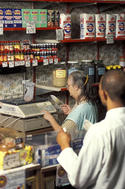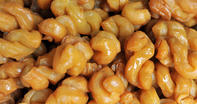Food in Supermarkets

Growing urbanisation has occurred in tandem with the emergence of the industrial food-production system, backed by the forces of globalisation, which looks unlike anything we have seen before in the history of our relationship with food.
The food hitting our supermarket shelves is a world away from the kinds of foods that were trickling into trading stores and village shops just a few years ago, and even from that which stocked grocery stores three decades ago.
The growth of supermarkets and supermarket chains in developing world markets has been overwhelmingly bullish, and while they still have the kinds of fresh fruit and vegetables you would find in the old-fashioned greengrocer, their own staple diet for commercial survival is the trade in processed and packaged foods, meat (fresh and frozen), and only then the traditional grocery store fresh foods.
And the occupants of the region’s cities are increasingly turning to supermarkets as a source of food, as opposed to informal markets within the city context.
Increasing Reach
Even though supermarkets only make up 2% of retail outlets in South Africa, for instance, 60% of the country’s food gets sold across their counters. ‘And the supermarket sector is growing rapidly,’ writes the University of Cape Town’s Dr Jane Battersby in an essay on the geography of the city and how food flows through it.
Supermarkets have increased their reach from ‘62% to 68% of the food market from 2008 to 2010, making significant inroads into township areas.
The recent surge can be attributed both to growing disposable income among African consumers, which has effectively opened new markets to the supermarkets and their subsidiaries, such as Boxer owned by Pick ‘n Pay and Sentra owned by Shoprite.
In addition, the improved infrastructure in many townships has made the presence of large retail businesses feasible.’ It is in the aisles of supermarkets that rural palates get exposed to ‘exotic’ foods and foods with a long shelf life, like ‘powdered milk, noodles and many varieties of sweet and savoury snack foods’, explains the Food and Agriculture Organisation (FAO) in its 2004 report on how the globalisation of food systems has influenced food security and nutrition in the developing world.
Industrialisation and Supermarketisation of Food

Highly refined, overly processed, sugared-up, heavily salted, high-fat foods that are loaded with preservatives for longevity are the stock-in-trade these days. So when we trawl up and down the supermarket aisle with our shopping trolleys, we find waiting for us, in neatly cellophaned convenience, energy-dense food that is packed with tasty, quick-release calories that are juiced up with flavour from fat, sugar and salt.
And since we do not have to work terribly hard to access that food and its energy, relative to how hard our ancestors had to work for the equivalent caloric intake 100 or 1 000 or 100 000 years ago, we tend to have plenty of energy going into our bodies, and not quite as much coming out.
Instead of having to spend all that time cooking, preparing and cleaning up around meals, the shift from individual to mass preparation ‘lowered the time price of food consumption’, states the UK- based medical journal The Lancet in its rather dramatic 2008 report on obesity.
The industrialisation of food production churns out ‘cheap, palatable, energy-dense foods’, and it ships it to us along ‘improved distribution systems that make food much more accessible and convenient’. And then the food industry’s hired guns – the people in the marketing department and their advertising companies – dangle this food in front of us with ever-more ‘persuasive and pervasive food marketing’, and this kind of predatory marketing has been shown to be linked with increased rates of obesity.
It is hardly surprising, then, that the industrialisation and the supermarketisation of our food and food-flow systems have changed our relationship with food – in terms of what we eat, how and when we eat, and how we regard that food from a cultural perspective.
And since the supermarket is the oasis of the city, it follows that urbanites increase the amount of brand-named, processed foods they choose to spend their money on. At the same time, according to the FAO report, we eat more of our meals outside of the home, and our behaviour regarding food is influenced by the appeal of ‘new’ foods. The desire to ‘be modern’ also shapes our relationship with food, says the FAO, both in terms of what we buy and how we prepare it.
Food as a Mark of Wealth
When Mickey Chopra and colleague Thandi Puoane, both professors in the School of Public Health at the University of the Western Cape, observed some of the perceptions of and value judgements people make around food, they found that in some parts of Jo’burg, fried foods are seen as a mark of ‘modern living and wealth, while food that is boiled is considered inferior and demonstrates outdated customs’.
Community health workers in Khayelitsha found similar attitudes when they spoke to fellow residents of the Cape Town township as part of a survey by a non-governmental healthcare organisation, Zanempilo. ‘People who boil food are not civilised,’ they were told by one person during a survey they conducted there. ‘Fried food is attractive, tasty such as Kentucky fried chicken.
If your neighbour boils food people say she is still backward because the food does not taste nor look attractive.’ Others said it was faster to fry food than boil it, and that fried meat tasted much better than boiled meat. And in townships, where there are fewer large supermarket chains and more spaza shops and independent retailers, food prices are often higher than in the city’s commercial hubs.
Supermarkets also tend to sell food in larger volumes, while spazas and independent township shops often repackage foods into smaller volumes, so even though the price-per-kilogram of food is more expensive in the smaller shops, the smaller packaging makes it more affordable to those on a tight budget.
It is probably a safer investment, too, since they do not have to store large quantities of food for a long time and risk it perishing. Some of the residents, when pressed on their food habits, said there was a shortage of ‘healthy, low-fat food and little fresh fruit and few vegetables’ for them to buy in the townships.
By Leonie Joubert